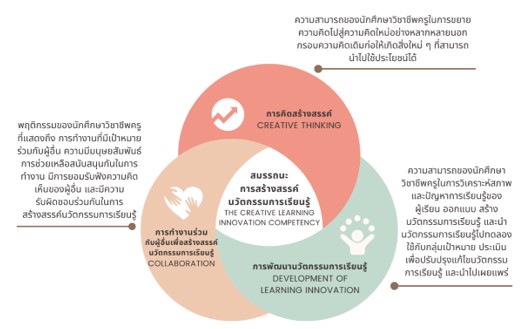Factors and Indicators of Creative Learning Innovation Competency of Student Teachers
DOI:
https://doi.org/10.14456/educu.2024.24Keywords:
factors and indicators, creative learning innovation competency, student teachersAbstract
The purpose of this research was to study the factors and indicators of creative learning innovation competency of student teachers. The data were collected from a group of 17 experts who were well-experienced in education and development of learning innovation using three rounds of the Delphi technique. The research instruments consisted of document analysis, an interview form for the first round, and 5-point rating scale questionnaires for the second and third round. The data were analyzed employing content analysis, median and interquartile range. The resulted revealed that the creative learning innovation competency of student teachers comprised of 3 factors and 47 indicators: (1) 11 indicators of creative thinking, (2) 27 indicators of development of learning innovation, and (3) 9 indicators of collaboration for learning innovation development. The aforementioned indicators reached a consensus among the experts with a median value of 4.00 or more and an interquartile range less than 1.00.
References
ภาษาไทย
กระทรวงศึกษาธิการ. (2562). มาตรฐานคุณวุฒิระดับปริญญาตรี สาขาครุศาสตร์และสาขาศึกษาศาสตร์ (หลักสูตรสี่ปี) พ.ศ.2562.
https://www.eqd.cmu.ac.th/Curr/doc/tqf%201/Bachelor%20of%20Education-4Y-2562_r.PDF
คณะกรรมการคุรุสภา. (2563). รายละเอียดมาตรฐานด้านความรู้และประสบการณ์วิชาชีพครู ตามข้อบังคับคุรุสภาว่าด้วยมาตรฐานวิชาชีพครู (ฉบับที่ 4) พ.ศ.2562. https://www.ratchakitcha.soc.go.th/DATA/PDF/2563/E/109/T_ 0010.PDF
จิราพร รอดพ่วง. (2559). การพัฒนารูปแบบชุมชนแห่งการเรียนรู้เชิงวิชาชีพเพื่อเสริมสร้างทักษะการจัดการเรียนรู้ การคิดอย่างเป็นระบบ และการสร้างสรรค์นวัตกรรมของนักศึกษาวิชาชีพครู [วิทยานิพนธ์ปริญญาดุษฎีบัณฑิต ไม่ได้ตีพิมพ์]. มหาวิทยาลัยศรีนครินทรวิโรฒ.
ฉัตรชัย หวังมีจงมี. (2560). สมรรถนะของครูไทยในศตวรรษที่ 21 : ปรับการเรียน เปลี่ยนสมรรถนะ. Journal of HRintelligence, 12(2), 47-63.
ณิรดา เวชญาลักษณ์. (2562). หลักการจัดการเรียนรู้. สำนักพิมพ์จุฬาลงกรณ์มหาวิทยาลัย.
ธานินทร์ ศิลป์จารุ. (2557). การวิจัยและวิเคราะห์ข้อมูลทางสถิติด้วย SPSS และ AMOS (พิมพ์ครั้งที่ 15). ห้างหุ้นส่วนสามัญบิสซิเนสอาร์แอนด์ดี.
ประพันธ์ศิริ สุเสารัจ. (2556). การพัฒนาการคิด. เทคนิค พริ้นติ้ง.
ไพฑูรย์ สินลารัตน์. (2558). ศาสตร์การคิด. มหาวิทยาลัยธุรกิจบัณฑิตย์.
วิจารณ์ พานิชย์. (2558). ทักษะครูเพื่อศิษย์ไทยในศตวรรษที่ 21. วารสารนวัตกรรมการเรียนรู้, 1(2), 9-14.
วิชัย วงษ์ใหญ่ และมารุต พัฒผล. (2560). กระบวนทัศน์การโค้ชเพื่อเสริมสร้างทักษะการสร้างสรรค์และนวัตกรรม (พิมพ์ครั้งที่ 2). จรัลสนิทวงศ์การพิมพ์.
วิชัย วงษ์ใหญ่ และมารุต พัฒผล. (2562). การพัฒนาทักษะสร้างสรรค์นวัตกรรม (พิมพ์ครั้งที่ 1). ศูนย์ผู้นำนวัตกรรมหลักสูตรและการเรียนรู้.
วิริยะ ฤาชัยพาณิชย์ และวรวรรณ นิมิตพงษ์กุล. (2562). สอนสร้างสรรค์ เรียนสนุก ยุค 4.0+. ซีเอ็ดยูเคชั่น.
วรรณดี สุทธินรากร. (2563). การวิจัยเชิงปฏิบัติการในชั้นเรียน “เพื่อสร้างความหมายใหม่ในการเรียนรู้”. สยามปริทัศน์.
สุคนธ์ สินธพานนท์. (2561). นวัตกรรมการเรียนการสอนของครูยุคใหม่เพื่อพัฒนาทักษะของผู้เรียนในศตวรรษที่ 21. 9119 เทคนิคพริ้นติ้ง.
สถาบันส่งเสริมการสอนวิทยาศาสตร์และเทคโนโลยี (สสวท.). (2555). ทักษะและกระบวนการทางคณิตศาสตร์ (พิมพ์ครั้งที่ 3 แก้ไขเพิ่มเติม). 3-คิว มีเดีย.
สำนักงาน ก.พ. (2559). การสร้างทีมงานที่มีประสิทธิภาพ. https://www2.ocsc.go.th/sites/default/files/document
/ocsc-2017-eb01.pdf
สำนักงาน ก.พ. (2559). การคิดเชิงสร้างสรรค์. https://www2.ocsc.go.th/sites/default/files/document/ocsc-2017-eb13.pdf
สำนักงานคณะกรรมการวิจัยแห่งชาติ. (2560). ยุทธศาสตร์การวิจัยและนวัตกรรม 20 ปี พ.ศ.2560 - 2579. บริษัท โคคูน แอนด์ โค จำกัด.
สำนักงานการวิจัยแห่งชาติ (2565). ประกาศผลการพิจารณารางวัลการวิจัยแห่งชาติ ประจำปีงบประมาณ 2565. https://nriis.go.th/FileUpload/AttatchFile/News/256411301016246202526.pdf
สำนักงานคณะกรรมการการศึกษาขั้นพื้นฐาน. (2553). คู่มือการประเมินสมรรถนะครู. https://www.tw-tutor.com/downloads/competency.pdf
สำนักงานราชบัณฑิตยสภา. (2558). พจนานุกรมศัพท์ศึกษาศาสตร์ร่วมสมัย ฉบับราชบัณฑิตยสภา. กรุงเทพฯ: สำนักงานราชบัณฑิตยสภา.
ภาษาอังกฤษ
Gates, S. (2018, October 18). Benefits of Collaboration. https://www.nea.org/professional-excellence/ student-engagement/tools-tips/benefits-collaboration
Bouchrika, I. (2024, June 10). Teacher Collaboration Guide: Strategies, Statistics & Benefits.
https://research.com/education/teacher-collaboration-guide
Kalra, A. (2020, September 24). Teacher collaboration in challenging learning environments. OECD Education and Skills Today. https://oecdedutoday.com/teacher-collaboration-challenging-learning-environments/
Ronfeldt, M., Farmer, S., McQueen, K., & Grissom, J. (2015). Teacher collaboration in instructional teams and student achievement. American Educational Research Journal, 52(3), 475-514.

Downloads
Published
How to Cite
Issue
Section
License

This work is licensed under a Creative Commons Attribution-NonCommercial-NoDerivatives 4.0 International License.



